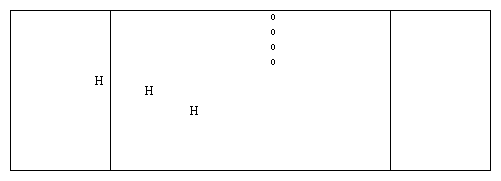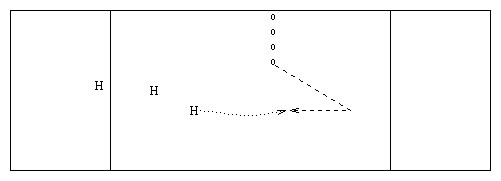|
|
|
The 3-4 offensive scheme is very simple. Other teams may use a version of this type of scheme, and call it an Iso or Handler Iso. Our scheme utilizes 3 Handlers and 4 Longs.
It is very important that the 4 Longs run downfield to set up
immediately upon the pull being thrown. This will help minimize the
possibility of poaching by the markers of the Longs. The 4 Longs are
to set up in a lateral stack about halfway down the field, on the left
side of the field (see figure).

Spacing between Longs should be about 3 feet, so that the center-most Long (called the Target) is about 15 to 20 feet from the sideline. The 3 outside Longs are basically decoys, and their job is to be a receiving threat, holding their markers near them. However, any one of the 3 outside Longs can (and should periodically) break for a pass, being careful to avoid a pick. The choice of which Long takes the Target role is determined by best mismatch, best Long, or simple rotation.
The Target is the most likely recipient of a pass, and is the first
option for a cut. The Target may cut long, laterally across the
field, or back towards the disc. One distinct advantage of this
scheme is that there should be no markers upfield from the lateral
stack, thus allowing the Target to cut to an area of the field
without poachers. Typically after a few receptions by the Target in
the endzone (or any long throw upfield from the stack),
the Target's marker will overplay the
long cut; this opens up the bowling alley, or comeback, cut
(see figure).

The key to success by the Handlers is patience. Essentially, the Handlers are playing 3 on 3, and should be able to move the disc without forcing it. One of the Handlers operates as a Dump (see the separate discussion of dump techniques); the Handler who takes the pull usually starts out as the Dump. That leaves the other 2 Handlers to work give-and-go passing down the field.
Each time a pass is caught by a Handler, a look should be made downfield to see what the Target is doing; if a pass is there, take it. If the disc stalls whilst in the process of being worked downfield by the Handlers, the Handler with the disc essentially has 2 options. First, a dump pass may be taken. Second, the pass to the upfield Handler is really a dump in reverse, and should not be difficult to initiate. Again, see the separate discussion of dump techniques.
If a non-scoring pass is made to a Target, there are two options. First, if the reception is made over 20 yards from the endzone, one of the Handlers takes a dump from the Target, and the lateral stack resets (the distance of the stack from the stationary disc is at least 25 yards). The Handlers, then, resume their give-and-go passing. Second, if the Target receives a non-scoring pass within 15 to 20 yards of the endzone, then the Target should call for the Endzone Play (see the separate discussion of the Endzone Play).